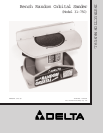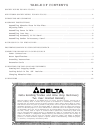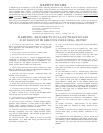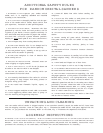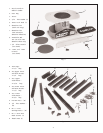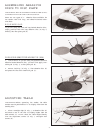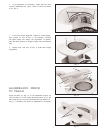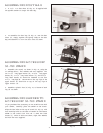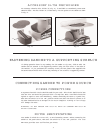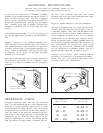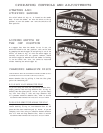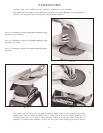
3
SAFETY RULES
W oodworking can be dangerous if safe and proper operating procedures are not followed. As with all machinery, there are cert ain
hazards involved with the operation of the product. Using the machine with respect and caution will considerably lessen the possi-
bility of personal injury. However, if normal safety precautions are overlooked or ignored, personal injury to the operator may result.
Safety equipment such as guards, push sticks, hold-downs, featherboards, goggles, dust masks and hearing protection can reduce
your potential for injury.But even the best guard won t make up for poor judgment, carelessness or inattention. Always use common
sense and exercise caution in the workshop. If a procedure feels dangerous, don t try it. Figure out an alternative procedure that feels
safer. REMEMBER: Your personal safety is your responsibility.
This machine was designed for certain applications only. Delta Machinery strongly recommends that this machine not be modified
and/or used for any application other than that for which it was designed. If you have any questions relative to a particular applica -
tion, DO N O T use the machine until you have first contacted Delta to determine if it can or should be performed on the product.
DELTA INTERNATIONAL MACHINERY CORP.
MANAGEROFTECHNICAL SERVICES
246 ALPHADRIVE
PITTSBURGH, PENNSYLVANIA 15238
(INCANADA:644 IMPERIAL ROAD, GUELPH, ONTARIO N1H 6M7)
W ARNING: FAILURE TO FOLLOW THESE RULES
M AY RESULT IN SERIOUS PERSONAL INJURY
1. FORYOUROWNSAFETY, READ INSTRUCTION
MANUALBEFOREOPERATING THE TOO L. Learn the
tool s application and limitations as well as the specific
hazards peculiar to it.
2. KEEP GUARDSINPLACEand in working order.
3. ALWAYSWEAREYEPROTECTION.
4. GROUNDALLTOOLS. If tool is equipped with three-
prong plug, it should be plugged into a three-hole electrical
receptacle. If an adapter is used to accommodate a two-
prong receptacle, the adapter lug must be attached to a
known ground. Never remove the third prong.
5. REMOVEADJUSTING KEYSANDWRENCHES. Form
habit of checking to see that keys and adjusting wrenches are
removed from tool before turning it on.
6. KEEP WORKAREACLEAN. Cluttered areas and
benches invite accidents.
7. DON TUSEINDANGEROUSENVIRONMENT. Don t
use power tools in damp or wet locations, or expose them
to rain. Keep work area well-lighted.
8. KEEP CHILDREN AND VISITO R S A W AY . All children
and visitors should be kept a safe distance from work area.
9. MAKEWORKSHOPCHILDPROOF with padlocks,
master switches, or by removing starter keys.
10. DON T FORCE TOOL. It will do the job better and be
safer at the rate for which it was designed.
11. USE RIGHT TOOL. Dont force tool or att achment to do
a job for which it was not designed.
12. WEARPROPERAPPAREL. No loose clothing, gloves,
neckties, rings, bracelets, or other jewelry to get caught in
moving parts. Nonslip footwear is recommended. Wear
protective hair covering to contain long hair.
13. ALW AYS USE SAFETY GLASSES.W ear safety glasses.
Everyday eyeglasses only have impact resist ant lenses;
they are not safety glasses. Also use face or dust mask if
cutting operation is dusty.
14. SECUREWORK. Use clamps or a vise to hold work
when practical. It s safer than using your hand and frees
both hands to operate tool.
15. DO N T O V E R R E A C H. Keep proper footing and balance
at all times.
16. MAINTAIN TOOLSINTOPCONDITION. Keep tools
sharp and clean for best and safest performance. Follow
instructions for lubricating and changing accessories.
17. DISCONNECT TOOLS before servicing and when
changing accessories such as blades, bits, cutters, etc.
18. USERECOMMENDEDACCESSORIES. The use of
accessories and attachments not recommended by Delt a
may cause hazards or risk of injury to persons.
19. REDUCETHE RISK O F UNINTENTIONAL START-
ING. Make sure switch is in OFF position before plugging
in power cord.
20. NEVERSTANDO N TOOL. Serious injury could occur
if the tool is tipped or if the cutting tool is accident ally
contacted.
21. CHECKDAMAGEDPARTS. Before further use of the
tool, a guard or other part that is damaged should be care-
fully checked to ensure that it will operate properly and
perform it s intended function check for alignment of moving
parts, binding of moving parts, breakage of parts, mounting,
and any other conditions that may affect its operation. A
guard or other part that is damaged should be properly
repaired or replaced.
22. DIRECTION O F FEED. Feed work into a blade or cutter
against the direction of rot ation of the blade or cutter only.
23.
NEVERLEAVETOOL RUNNING UNATTENDED. TURN
POWEROFF
. Don t leave tool until it comes to a complete
stop.
24. DRUGS, ALCOHOL, MEDICATION. Do not operate
tool while under the influence of drugs, alcohol or any
medication.
25. MAKESURETOOLISDISCONNECTED FROM POWER
SUPPLY
while motor is being mounted, connected or re-
connected.
26. W ARNING: The dust generated by certain woods and
wood products can be injurious to your health. Always oper-
ate machinery in well ventilated areas and provide for proper
dust removal. Use wood dust collection systems whenever
possible.



